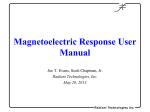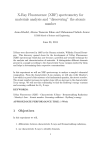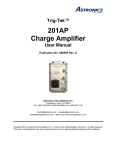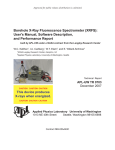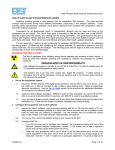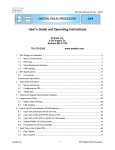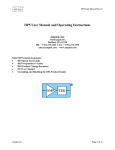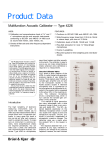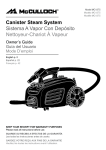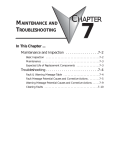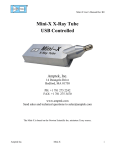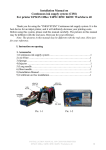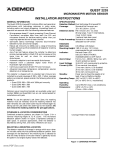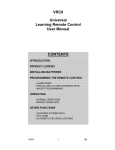Download Amptek A250CF “CoolFET”
Transcript
Charge Sensitive Preamplifier A250CF CoolFET Amptek sets the New State-of-the-Art... Again! with Cooled FET Performance • Noise: 670 eV FWHM (Si) ~76 electrons RMS • Noise Slope: 11.5 eV/pF High Ciss FET • Fast Rise Time: 2.5 ns Features • Thermoelectrically Cooled FET • 3 FETs to match detector • Lowest Noise and Noise Slope • AC or DC coupling to the detector • Easy to use • Both Energy and Timing outputs • Optional input protection RUN SILENT...RUN FAST...RUN COOL! The Amptek A250CF "Cool FET" Charge Sensitive Preamplifier is the lowest noise, general purpose, preamplifier available. It is designed to give the ultimate performance when used with either low or high detector capacitance detectors and is a direct replacement for other higher noise charge sensitive preamplifiers. The A250CF “CoolFET” technology uses a thermoelectric (Peltier) cooler to keep the input FET(s) at -50 °C. Cooling is totally transparent to the user. Hence, the A250CF “CoolFET” operates like a room temperature preamplifier. Based on the successful A250 designed for high performance satellite instrumentation, the A250CF "CoolFET" re-defines the new state-of-the-art. Power to the A250CF "CoolFET" is provided by an external stable power supply (included). Detector bias can be applied via an SHV connector. Input, Energy (E) Output, Timing (T) Output, and Test are provided via BNC connectors. 100 Noise (Si equivalent keV FWHM) Low Ciss High Ciss 10 1 0.1 1 10 100 1000 Detector Capacitance (pF) Figure 2. Noise as a function of FET and detector capacitance. D.C. Coupled. Amptek A250CF CoolFET User Manual - Preliminary Page 1 of 7 Charge Sensitive Preamplifier A250CF CoolFET 1 Warnings Under normal operation, a high voltage bias is applied across the detector that is used with the Amptek A250CF preamplifier. The user must exercise care when the detector is biased. Moreover, the bias circuitry has a very long time constant and so this circuitry, including the A250CF’s input node, can remain at a high voltage for a very long time. If the user does not exercise suitable caution, this voltage can possibly cause personal injury. More likely, however, is that this voltage could damage or destroy either the detector or the A250CF and void warranty if proper care and operation are not exercised as discussed in this manual. The input circuit will be destroyed if the detector input capacitor is shorted while the detector bias components are charged. These capacitors retain charge for a long period of time. A short circuit, which can result from connecting a detector, cable, or capacitor, will cause the applied bias voltage (stored on the input capacitor) to be coupled directly to the input FET, causing catastrophic damage to the FET inside the CoolFET hybrid. To avoid the possibility of such damage, please observe the following precautions: 1. Completely discharge the detector bias circuit by turning off the bias supply before connecting a cable, capacitor, or any other device to the Detector Input connection on the front panel of the preamplifier. 2. To discharge the circuit if a variable HV supply is used, turn the voltage control to zero and leave it there for are least 30 seconds. The bias circuitry will discharge itself through the output of the bias supply. Otherwise, connect a low impedance, ideally a short circuit, across the Detector Bias SHV connector on the rear panel of the preamplifier for at least 30 seconds. Do not short the Detector Input connector on the preamplifier. The preamplifier includes a protection circuit that is enabled when the unit ships from the factory, which protects the input FET from destruction due to large transients under abnormal operating conditions. It is important to note that this circuit protects the FET and not the detector. If the detector breaks down due to over voltage, the protection circuit prevents damage to the preamplifier/FET. The protection circuit does add to the electronic noise of the preamplifier, so if the lowest noise is required, this circuit can be removed, as described later in this manual. However, this leaves the FET susceptible to damage by a variety of transients. The “half life” of an unprotected FET is much shorter than that of a protected FET, so there is a trade-off between the very lowest noise and risk. Damage caused during unprotected operation is not covered under warranty unless the precautions outlined here are followed. Amptek A250CF CoolFET User Manual - Preliminary 2 2.1 Overview Description The A250CF is a charge sensitive preamplifier. The input to the preamplifier is the signal from a radiation detector, a current pulse of short duration (mseconds or less). The total energy deposited is proportional to the total charge generated. The primary output of A250CF (the energy output) is a voltage step proportional to the input charge, the time integral of the current pulse, with a gain of 176 mV/MeV (Si). This step has a fast rise (the rise time of the A250CF is 2.5 nsec for 0 capacitance) and a slow decay to baseline (500 msec). This energy output is generally sent to a shaping amplifier and is used for spectroscopic measurements. The timing output has a much faster decay, 1 msec, and is used as the input to a timing circuit. The A250CF consists of several main function blocks. The core of the preamplifier is the charge amplifier itself, which consists of the CoolFET hybrid, the A250 amplifier, and the feedback components. This circuit produces the voltage output for a current input, and determines the output noise and risetime. The series noise of a preamplifier is at its minimum when the input capacitance is comparable to the FET capacitance. The A250CF includes a jumper that permit the user to select 1 of 3 FETs, to match capacitance. Jumpers are used to connect the gates to the input, to connect the commensurate drains, and to select the proper drain resistor, to set the drain current. There are additional circuit elements in the A250CF, including (1) connections to detector bias, (2) optional input protection circuitry (enabled when shipped from the factory), (3) a test input, (4) an amplifier which buffers the energy output and provides for polarity and offset adjustments, (5) an amplifier which buffers the timing output and provides for polarity adjustment, and (6) power supply circuitry. Page 2 of 7 Charge Sensitive Preamplifier A250CF CoolFET Drain Current Jumpers Bias SHV Drain Jumpers Offset Adjust 100 MΩ Gate Jumpers Gain of 2 Optional Invert Energy Gain of 2 Optional Invert Timing A250 DC or AC Coupling Input Protection Jumper Input Thermoelectric Cooler 49.9 CoolFET Hybrid Test +/- 8V 1 GΩ +/- 5V Power Supply +3.3V TEC Pwr 0.5 pF Figure 1. Bock Diagram of A250CF "CoolFET." 2.2 4 V/pC 0. 64 µV/electron CoolFET Hybrid The CoolFET hybrid contains three (3) FETs that are placed on top of a thermoelectric cooler and enclosed in a TO-8 package. There are two main advantages to cooling the FET: it reduces the leakage current and increases the transconductance, both of which reduce the electronic noise of the system. The increased transconductance provides a much improved noise slope (eV/pF) over un-cooled systems, which is especially important for large capacitance detectors. 3 3.1 FET Capacitance (Ciss): FET 1 and 2 Low Ciss: 15 pF FET 3 High Ciss: 30 pF Rise Time: 2.5 nsec at 0 pF Integral Nonlinearity: < 0.03% 3.2 Inputs Specifications Detector Input: Positive or negative input signals from semiconductor detectors. Performance Bias: Detector bias voltage, maximum 1 kV, from a power supply. Noise at 0 pF (keV) (2 µs shaping) CoolFET Test: Input voltage pulses for system test and calibration. Noise Slope (eV/pF) 100 MΩ Type DC coupled Low Ciss 0.670 1.20 13 High Ciss 0.850 1.35 11.5 Bias Table 1. Typical noise data for A250CF. The noise depends on (1) the detector capacitance, (2) input configuration (AC vs DC coupling, use of input protection), and (3) which CoolFET is used. 3.3 Outputs Energy (E): Provides an output voltage step proportional to the input charge. Nominal gain is 176 mV/MeV (Si). Polarity and DC offset are adjustable. Output Impedance is 50 Ohms. Dynamic Range: ± 4 V, offset adjustable to ± 6 V Timing: Provides a tail pulse (1 msec decay) for system timing measurements. Polarity is adjustable. (see below). Output Impedance is 50 Ohms. Gain: With a 0.5 pF feedback capacitor and a gain of 2 in the output buffer. 176 mV/MeV (Si) 220 mV/MeV (Ge) 144 mV/MeV (CdTe) 152 mV/MeV (HgI2) Amptek A250CF CoolFET User Manual - Preliminary Page 3 of 7 Charge Sensitive Preamplifier A250CF CoolFET Please contact the factory if there are any questions about the proper selection/soldering procedure. 1.0 Normalized Amplitude (V) 0.9 Energy 0.8 4.1 0.7 FET Selection The A250CF contains three cooled FETs. FETs 1 and 2 are low Ciss =15 pF and FET 3 is high Ciss=30 pF. Use FET 1 or 2 for low capacitance detectors and FET 3 for high capacitance detectors (>100 pF). 0.6 0.5 0.4 0.3 To select FET 1: 1. Set JP8 to Pin 5 2. Set JP7 to jumper 1-2 0.2 0.1 0.0 Normalized Amplitude (V) -50 0 50 100 150 Time (msec.) 1.0 0.9 0.8 0.7 0.6 0.5 0.4 0.3 0.2 0.1 0.0 200 250 To select FET 2: 1. Set JP8 to Pin 6 2. Set JP7 to jumper 3-4 To select FET 3: 1. Set JP8 to Pin 7 2. Set JP7 to jumper 7-8 Energy Output Timing Output 0 100 200 Time (nsec.) 300 400 Figure 3. Timing and energy outputs from a typical test pulser. 3.4 Connections Input, Test, Energy, Timing: BNC Bias: SHV 3.5 Power 3.3 V DC at 1.6 A (AC power adapter included) 3.6 Mechanical Size: 3.5” x 2.5 “ Weight: 28 g 4 Preamplifier Configuration, Adjustment, and FET Selection IMPORTANT JP6 (drain current resistor selection) and JP7 (FET Drain selection) have jumpers installed that facilitate selection. The Input Protection selection and the FET Gate selection, however, have posts to which the user must solder in order to make the appropriate selection. This is to ensure the best noise performance. The user must exercise EXTREME caution while soldering these posts. Amptek A250CF CoolFET User Manual - Preliminary Figure 4. 4.2 Drain Current Resistors JP6 sets the drain current resistor. There are three (3) selectable resistors. • Position 1-2: R34 = 220 Ohms • Position 3-4: R35 = 110 Ohms • Position 5-6: R36 = 110 Ohms Under most circumstances the best performance is achieved with 220 Ohms for the CoolFet FETs. If the user disables the CoolFET and uses and external FET, then one (or a combination) of the other positions may yield the best results. Also, at higher detector capacitances a lower value may improve noise results. Page 4 of 7 Charge Sensitive Preamplifier A250CF CoolFET 4.3 AC and DC Coupling The A250CF is shipped from the factory configured for AC coupling with the Bias resistor and filter installed. The Bias is connected through a teflon post to the BNC side of the input capacitor by a wire. To DC couple the A250CF the user must remove the connection from this post to input capacitor and then solder a jumper wire across the input capacitor or remove it and make a direct connection to the input node. 4.4 Input Protection The A250CF is shipped with the protection network enabled (ah shown in figure 5). The best noise performance is obtained without any protection, but the risk of damage is much higher. Follow the precautions outlined in Section 1 when disabling the protection. The diode protection degrades the noise performance more the higher the dectector capacitance. 4.5 Energy Output (E) The Output of the A250 is buffered by an amplifier with a Gain of 2. Both the polarity and the offset of the Energy Output (E) can be user adjusted. Output Impedance is 50 Ohms. The DC offset of the energy output can be adjusted by using potentiometer R9. It is “zeroed” when shipped from the factory. If a grater dynamic range is needed in one direction (i.e. positive or negative), the user can adjust this. For example, if a greater positive dynamic range is needed, this can be adjusted negative. The Energy Output (E) can be inverted by using switch S1. 4.6 Timing Output (T) The Timing Output (T) is buffered by an amplifier with a gain of 2. The polarity of the timing output can be toggled by using switch S2. Output Impedance is 50 Ohms 5 Testing via “Test” Input The A250CF can be tested with a pulser to inject a test charge into the Test input. The unit will respond to both the negative and positive edge of the test pulse which should have a transition time of less than 20 ns. A square wave or a tail pulse with long fall time (>100 µs) may be used. Charge transfer to the input of the A250CF is being applied only during the transition time according to Q = CtV, where Q = total charge transferred, Ct = value of test capacitor, and V = amplitude of voltage step. DO NOT connect the test pulser to the input directly or through a test capacitor greater than 100 pF as this can produce a large current pulse at the input FET and cause irreversible damage. Figure 5. Shows the protection network enabled. D1 is soldered and the R5 jumper is not soldered. Refer to shcematics at end of manual. Input waveform: Square wave, or Tail pulse (Tr < 20ns, Tf > 100 µs) Amplitude: V = Q/Ct = 1 V/picoCoulomb for Ct = 1 pF Example: To simulate 1 MeV in Si detector: 1 MeV (Si) = 0.044 pC, (1 V/pC)( 0.044 pC) = 44 mV Hence, a 44 mV step into 1 pF test capacitor simulates the charge generated in a silicon detector by a particle when it loses 1 MeV of its energy. NOTE: The internal test capacitor (0.5 pF) is not a calibrated capacitor. It is provided to facilitate the testing of the preamplifier and not to make absolute noise measurements. Figure 6. Shows the protection network disabled. D1 is not sodlered and the R5 jumper is sodlered. Amptek A250CF CoolFET User Manual - Preliminary Page 5 of 7 Charge Sensitive Preamplifier A250CF CoolFET 6 Noise Measurement The noise of a charge sensitive preamplifier must be tested together with the post amplifier/shaper. The A250CF noise characteristics given in the specifications are associated with a 2 µs shaping time constant in the post amplifier. The post amplifier must have very low input noise as in the case of NIM electronics amplifiers or the Amptek A275, so that its contribution to the measurement is minimal. The function of the post amplifier is not only to preserve and amplify the linear information received by the charge amplifier, but also to provide a band pass filter to eliminate frequencies that contribute to noise. Conversion: 1 keV FWHM (Si) = 113 electrons RMS = 1.81 x 10-17 Coulombs RMS When measuring noise of the entire system either by the MCA or the RMS voltmeter method the detector must be simultaneously connected with the test circuit to the input of the A250CF. The noise measurement in this case will include the contribution from the detector due to both its capacitance and its leakage current. Two methods are normally used to measure noise in the preamplifier: The first is by using a Multichannel Analyzer (MCA), and the second is with a wide-bandwidth RMS AC voltmeter. 6.1 Noise Measurement Using an MCA Connect a calibrated capacitor (1-2 pF, not provided) to the Input of the A250CF. Stimulate with a pulse of known amplitude as in the Section 5. 1. Connect the A250CF Energy Outpu (E) to the post amplifier/shaper with the correct shaping time constant (1-3 µs for solid state detectors.) 2. Connect the post amplifier output to the MCA input. 3. Calibrate the MCA, in pC/channel or keV/channel, by observing two peaks formed by two different known amplitude test pulses. 4. The Full Width at Half Maximum (FWHM) of a particular energy peak can now be read directly from the analyzer. 6.2 Noise Measurement Using RMS Voltmeter Connect a calibrated capacitor (1-2 pF, not provided) to the Input of the A250CF. Stimulate with a pulse of known amplitude as in the Section 5. The FWHM noise using the RMS voltmeter is given by: FWHM (keV, Si) = 2.35 (Vrms) (Vin)/(Vout) Where: • Vrms is the noise in volts from the voltmeter. • Vin is the input test pulse in keV equivalent. • Vout is the output pulse in volts from the post amplifier. Example: With a 2 pF test capacitor 1. Set Vin = 22 mV (1 MeV, Si) 2. Set Post amplifier's gain to obtain 2.35 Volts output pulse 3. The RMS voltmeter is now calibrated to: 1 mV RMS = 1 keV FWHM (Si) 4. Remove the test pulser, cover the input BNC, and read the RMS voltmeter. Amptek A250CF CoolFET User Manual - Preliminary Page 6 of 7 Charge Sensitive Preamplifier A250CF CoolFET 7 Schematic Amptek A250CF CoolFET User Manual - Preliminary Page 7 of 7









